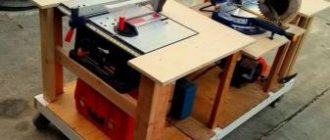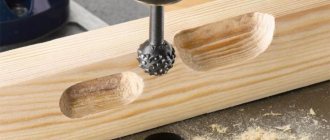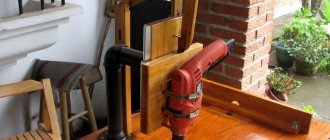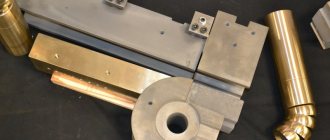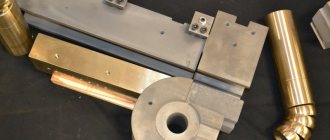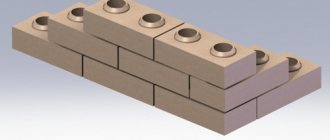by Alexey | Tools | Wednesday, December 15, 2021
| Follow Make-Self.net on Facebook and be the first to read our articles. |
A router is a very useful tool in woodworking. It can be used for shaping wood, drilling various holes, cutting grooves, finishing edges and much more. It's hard to imagine any complex project without it.
A router table may be the most important tool a carpenter can use.
Most people use routers as portable tools. While this is a viable option, a table-mounted router is safer to use and can perform its functions on a whole different level. If you're looking to build your own router table yourself, you've come to the right place. We've rounded up 13 of the best DIY table designs.
Folding milling table
This briefcase-sized design transforms into a fully functional router in minutes and folds up for storage just as quickly.
A full-size router table can be a great solution—if you have the space. But if you only use the router occasionally or need a mobile solution, this might be a good solution. This benchtop tool provides all the precision and stability you'd expect from a full-size router table.
How to make a wood lathe with your own hands: drawings and technology
The easiest way to make a tool yourself at home is to construct a lathe or milling machine from a drill or electric motor removed from another tool. This process is not that complicated, so every master can handle it. To do this, you will need an electric motor, the power of which does not exceed 500 W, and available materials. A drill can also be used as a drive. Of course, making a lathe will require some skill.
The device of the tailstock of a homemade wood lathe
To build the machine, the following elements are required:
- metal frame;
- electric motor;
- handyman;
- tailstock.
It wouldn’t hurt to get a drawing that will help you navigate the dimensions and correctly manufacture all the structural elements for its subsequent assembly.
How to make a homemade drilling machine with your own hands with a motor
First you need to prepare the electric motor shaft. To do this, a faceplate is installed on it; a steel center with a thread is also suitable. Installation of the second center is carried out in the tailstock tube. To make the frame, you will need a pair of corners measuring 5x3 cm, their length is 15 cm. A motor is attached to the frame using a bolted connection.
An example of a homemade drilling machine
Note! The central part of the tailstock must coincide with the middle of the electric motor shaft.
At the next stage of making a homemade machine, you assemble the headstock yourself. This element is formed from a pair of horizontal and a pair of vertical corners. A pipe intended for the spindle is attached to it. You need to insert a bolt into it, the diameter of which is 1.2 cm. First, its head is sharpened at a right angle. Thus, the central part of the spindle is designated. After this, the headstock is installed on the bed. On the top post, which connects to the horizontal corners, it is necessary to secure the tube by welding.
To make a tool rest, you need to take a steel rod with a chamfer. This element must also have a hole that will be used to secure the support ruler. It is necessary to vertically weld the tube with the locking screw to the long angle. Then the tool rest rod is inserted into it.
The motor rotor on which the faceplate is attached will be used as the headstock spindle. You need to make several holes in it. A fork will be inserted in the central part. The holes along the edges are intended for fixing the part with screws.
Even with the help of simple tools you can create interesting wooden products; for this you need to study the technology of working with the tool and practice
How to make a wood lathe from a drill with your own hands
Having a workbench with a strong and flat working surface at hand, you can build a lathe without resorting to building a bed. The electric drill in this case will serve as a rotary drive and headstock. According to the simplest drawing of the machine, it is enough to fix this tool on the surface of the workbench through the neck. Clamps and a clamp are suitable for fixing.
Next you need to make a stop that will act as a tailstock.
This element is mounted opposite the drill. To create it, you can take two blocks of wood and an adjusting screw, sharpened at one end to a cone. If you intend to use the machine for processing massive wooden workpieces, then it is advisable to fix the stop on the table using clamps.
To make a tool with your own hands, inexpensive materials are enough. A drill-based lathe can be used to turn various parts:
- door handles;
- structural details of the staircase;
- decorative items, etc.
Using a workbench with a durable and flat working surface, you can make a lathe from a drill with your own hands
Note! The machine with a wooden clamp is suitable exclusively for processing wood blanks. It is not allowed to use such a tool for working with metal.
To expand the functionality of the tool, its design can be supplemented with attachments and other devices that can improve the quality of work.
Such improvements include:
- winding on transformers;
- applying a coloring composition over a rotating part to create patterns;
- applying spiral notches to the workpiece, etc.
Installing a special attachment in the form of a copier will allow you to use the machine to create a whole series of identical parts or products according to a template.
An example of a multifunctional homemade woodworking machine from a drill
Spacious milling table on wheels
If you're a fan of Ana White, then you know that she has everything you could ever want to build.
It's no surprise that she has a great plan for helping you build a great router table. It has ample storage and work space. I hope you enjoy it as much as we do.
Classification
The unit in question is a carefully polished surface, where there are so-called T-shaped grooves intended for positioning the workpiece. The grooves are placed either along a circular arc or in the longitudinal direction (less often - in the transverse direction). Accordingly, a distinction is made between round and rectangular rotary tables.
With the presence of such a unit, metal removal (during milling, planing and other similar operations) can be carried out simultaneously in three coordinates X, Y, Z, and with simultaneous rotation of the workpiece to any required angle. Functionality is especially enhanced if the horizontal rotary table is installed on a machine equipped with a CNC system. In this case, high-precision design of such complex transitions as spiral grooves, round radius transitions and other contour elements of increased complexity is permissible.
The rotary table can be designed and manufactured in the following options:
- Round: here it is possible to process workpieces along a circular arc or obtain helical surfaces. When placing T-slots along an arc, several initial workpieces can be installed simultaneously.
- Vertically tiltable rotary table: it allows milling operations on composite structures, including those located perpendicular to each other.
- Vertically tiltable with rotary disks: if they are present on the machine, you can perform milling operations with several workpieces without reinstalling them.
- Horizontal rotary table, which provides the opportunity for milling work with workpieces of increased overall dimensions; This design option is suitable for small-sized equipment.
- Rotary table equipped with a vacuum grip. With this design, the milled workpiece can be fixed on any plane, in horizontal/vertical positions, and at any angle. Used on CNC machines.
Professional milling table at half the price
This table includes all the best features found in store bought router tables at half the price! We have had the opportunity to study and use most of the router tables available on the market. Based on this experience, we developed our own fully functional and easy to assemble desk. The detailed project can be viewed here.
Do-it-yourself wood milling machine: design specificity
Wood milling machines can have different purposes. Some devices are designed to perform only one operation, others are multifunctional. Buying a professional tool is an expensive pleasure, so many craftsmen resort to making a woodworking machine with their own hands. Most often, this router is used in small furniture workshops.
Using a milling machine, you can perform operations such as shaped edge processing, cutting groove and through holes, etc.
Routers are usually used to process wood along straight or curved contours. The working element in the design is the knife head, which carries out rotational movements. In most cases, this part is located vertically. There are many types of routers, each of which has its own design features.
The most popular types of devices:
- standard single-spindle (the spindle is located vertically);
- single-spindle designs, where the spindle or homemade milling table tilts;
- copy milling cutters with a top-mounted spindle;
- copying structures with a horizontal spindle (the tool is designed for processing wooden propellers).
Note! In all of the listed designs, except the last one, the material is fed manually.
Milling machine design: single-spindle designs
The design of a single-spindle machine includes a horizontal table with a pair of tongue-and-groove sockets designed for fixing guide rulers. It is installed on a cast iron frame. Under the table there are slides that move along guides. They have a spindle mounted on a thrust bearing and a pair of bearings. At the top of this element there is another spindle - a plug-in one. It is designed for mounting cutting parts.
For machining large workpieces, it is necessary to use a reinforced spindle
The slide with spindle can be raised if necessary. For this purpose, a bevel gear with a handwheel or a screw is used. A belt drive allows the spindle to move. Moreover, a counter drive, a motor or a motor shaft can be used for this.
To make such a wood router with your own hands, you need to take into account some nuances. In some cases, it is impossible to do without additional spindle reinforcement. This need arises if it is necessary to process workpieces of great height or if the part is subject to serious loads. To do this, you need to install and secure the upper stop on the machine table. This element is fixed on the bracket. To control the movement of the workpiece during the milling process, it is advisable to use a guide ring or ruler.
Machines in which the spindle or table tilts allow you to do a wider range of DIY woodworking jobs. In addition to standard operations, such designs allow for higher quality processing, obtaining a clean and uniform surface. This result can be achieved by processing wood at an angle, using cutters with a very small diameter. A device with a tilting spindle is much safer and more convenient.
The device of a homemade wood copying machine with an upper spindle placement
These devices are used to perform copying work. This does not require high power. Such designs allow milling and drilling to create openwork products.
Homemade copy milling machine for wood
The copier can replace three tools at once:
- Fraser.
- Drilling machine.
- Jigsaw.
Wood processing is carried out using cutting mills. The spindle develops a large number of revolutions, due to which the processed surface is very clean.
A homemade woodworking machine can be used for various purposes:
- calibration of bosses;
- production of openwork frames;
- working out the walls of the ribs, etc.
The basis for this design is a frame made of cast iron. Its upper part is curved in the shape of a sickle. This area is used for mounting the electric motor.
Having made a durable and reliable design of the machine, it can be used to perform various operations with wood
Note! The bed serves as a connecting link on which all the elements of a homemade wood milling machine are installed. The stronger and more reliable its design, the better.
The engine is mounted on guides. Due to the system of levers, it can move up and down these elements. This section is set in motion by pressing the pedal, which is equipped with a special stopper. The rotor shaft of the engine is connected to the spindle, where the chuck with the tool is secured. This cartridge can be self-centering or American.
In the lower zone of the frame, a table is mounted on a movable bracket. This design can move vertically along the guides using a handwheel. There are other options for making a homemade wood milling machine with your own hands; a drawing of such a design involves vertical movement of the table also during operation by pressing the pedal. In such models, the electric motor and spindle remain stationary.
Wall cabinet for router
This compact storage cabinet does double duty as a top-notch router table while also holding all your accessories.
With plenty of storage and a built-in desk, this cabinet allows you to knock two important items off your list. And here's what's interesting: it takes up very little space. The secret to its compactness is that it folds out when you need it and retracts when you're done.
What components and materials are needed for the work?
To create power components, steel angles and pipes with a minimum wall density of 2 mm are used. Their connection options are welding or screws. All metal components are coated with primer and paint to protect them from corrosion.
Durable grades of chipboard and plywood are suitable for the countertop and some other elements. They are resistant to moisture, temperature changes and other dangerous factors.
Electric motor
It is needed when you plan to create a small CNC router. Its most important parameter is power. It is better to use a 1100 W device. It will allow you to use a variety of cutters.
You can also use a motor from hand-held power tools: drill, hammer drill or grinder.
engine's type
For optimal operation, you can base the machine on an asynchronous unit with three phases. Then the router will connect to the network and follow a special circuit. It uses an algorithm. Due to this, the engine starts smoothly and allows the machine to operate at maximum power.
If such a motor is connected to a single-phase network, it will lose 50% of its efficiency. If the network does not allow this type of connection, then use a 1-2 phase motor.
https://youtube.com/watch?v=SrjCu2i7wRw
Milling small parts
Several router table accessories make it easy to achieve safe and accurate results.
The problem with small workpieces is that there are large holes in the tabletop, and the stops can cause small parts to get stuck. This can ruin the project and be unsafe. This router table attachment holds small parts and allows the workpiece to be pushed past the router bit for precise and safe cutting.
Follow us on Pinterest for more interesting articles.
Useful short videos from Make-Self.net
Manufacturing stages
As an example of work, we took a case where an old table served as the basis for the machine. If this is not the case, then before the work described below, you need to make another base. Bars of the same length are used for the legs, the structure is reinforced with transverse elements. The base must be strong and stable in order to withstand active use. After this, work begins on the countertop.
Stage one
The working surface is cut out in accordance with the previously prepared dimensions. By the way, you can even use an old countertop from, for example, a kitchen table. The main thing is that the material is durable and can withstand all mechanical loads.
An important characteristic is the thickness of the tabletop. Carpenters say that it is best when the thickness is 2 cm. Such a tabletop will be durable, no matter what material it is made of, and will leave a large working surface for the saw. Simply put, the more the blade “sticks out” from the machine, the deeper it can cut.
If possible, the edges of the board should be milled and sanded.
This is important not only for the beautiful appearance of the structure, but also for its durability and operating comfort. And no one wants splinters
Stage two
A hole is made in the tabletop for a circular saw. Remember that it must match the size of the disk. Also on the surface of the tabletop you need to draw a place for installing and fastening the saw.
Stage three
Holes are made in the working surface to secure it to the base. The tabletop turns over. To firmly connect these two parts of the machine, self-tapping screws and steel angles are used. By the way, to make the process of installing the saw more convenient later, you don’t have to fasten the tabletop right away.
Stage four
The power supply and switching system of the device is being installed. The design provides that the saw will always be on, so clamps are needed to secure the corresponding button. The starting and stopping of the machine will be controlled by turning the power supply on and off. Therefore, you will need a regular switch, cable, and socket.
An outlet is installed inside, from which the power cord for the switch comes out. It is the switch that will start or stop the machine, so it should be at hand so that in the event of an emergency the master can quickly turn off the saw with one click. All this is connected to the nearest outlet in the work area.
Stage five
A frame is made for convenient work with cross cuts. You can make such a carriage from a thin base and two low walls. Wood and plywood are suitable for this. To make the structure movable, guides for the table are prepared. These can be small parts of a steel pipe with a cross-section of 2x1 cm. The pipe sections are mounted in grooves that have been previously cut with a milling cutter. This simple design will significantly increase the capabilities and comfort of the machine.
Stage six
The accuracy of the work is important, so the machine must be equipped with a marking ruler. Using a router, a small groove is made for installing a ruler. If there is no such tool, then the groove can be prepared with a chisel. The surface of the tabletop is carefully processed with a grinding machine and sandpaper. It is most convenient to fix the ruler using self-tapping bolts. This modification will allow you to cut the material with millimeter precision.
Additional design improvements
For convenient use of the machine, design improvements are being made. A container for collecting chips and a stand with a dust extraction are often installed for cleaner work. The working surface can be folding, which saves space, and even liftable, which will provide quick access to the saw.
Some craftsmen remove the casing from the tool, which makes a large working surface of the saw blade available. A special block for pushing boards is also prepared
This is important for safety. In order not to lose this block, a special stand or drawer is made for it


